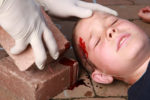Cerebral Compression is where there is pressure on the brain caused by swelling or bleeding. This is a very serious condition and the Emergency Medical Services should be alerted. The swelling can be due to a build-up of blood within the skull or swelling of injured brain tissues. This may be caused by cerebral contusion, […]
Types of Bleeding
Bleeding is categorised based on the affected blood vessels:
- Arterial Bleeding: Characterised by bright red, spurting blood due to high pressure in arteries. Immediate intervention is crucial. Learn more about serious bleeding.
- Venous Bleeding: Involves dark red, steady-flowing blood from veins. Prompt action is necessary to control the bleed. Understand different types of bleeding.
- Capillary Bleeding: Features slow, oozing blood from capillaries, often in superficial wounds. Typically manageable with basic first aid. Explore minor injury management.
Immediate First Aid Steps
For effective bleeding control:
- Ensure Personal Safety: Wear gloves to prevent infection.
- Apply Direct Pressure: Use a sterile dressing to press firmly on the wound. Watch our video on serious bleeding and bandaging.
- Elevate the Injured Area: Raise the wound above heart level to reduce blood flow.
- Use Pressure Bandages: Secure the dressing with a bandage to maintain pressure. Learn how to apply an elevation sling.
- Avoid Removing Embedded Objects: Stabilise objects in the wound without removal. Read about handling embedded objects.
- Seek Medical Assistance: For severe bleeding, call emergency services immediately.
Advanced Bleeding Control Techniques
In cases of catastrophic bleeding:
- Tourniquets: Apply to limbs to constrict blood flow when direct pressure is insufficient. Proper training is essential. Discover more about commercial tourniquets.
- Haemostatic Dressings: Specialized dressings that promote rapid clotting, used in conjunction with direct pressure. Find out about haemostatic dressings.
Preventing Bleeding Incidents
To minimize bleeding risks:
- Use Protective Equipment: Wear appropriate gear during activities prone to injury.
- Maintain a Safe Environment: Keep living and workspaces free from hazards.
- Handle Tools and Equipment Safely: Follow safety protocols to prevent accidents.
- Stay Informed: Regularly update first aid knowledge and skills. Enroll in our First Aid at Work Annual Refresher course.
Further Resources
Enhance your understanding of bleeding management:
For professional first aid training, consider our First Aid at Work Annual Refresher (VTQ) course.

